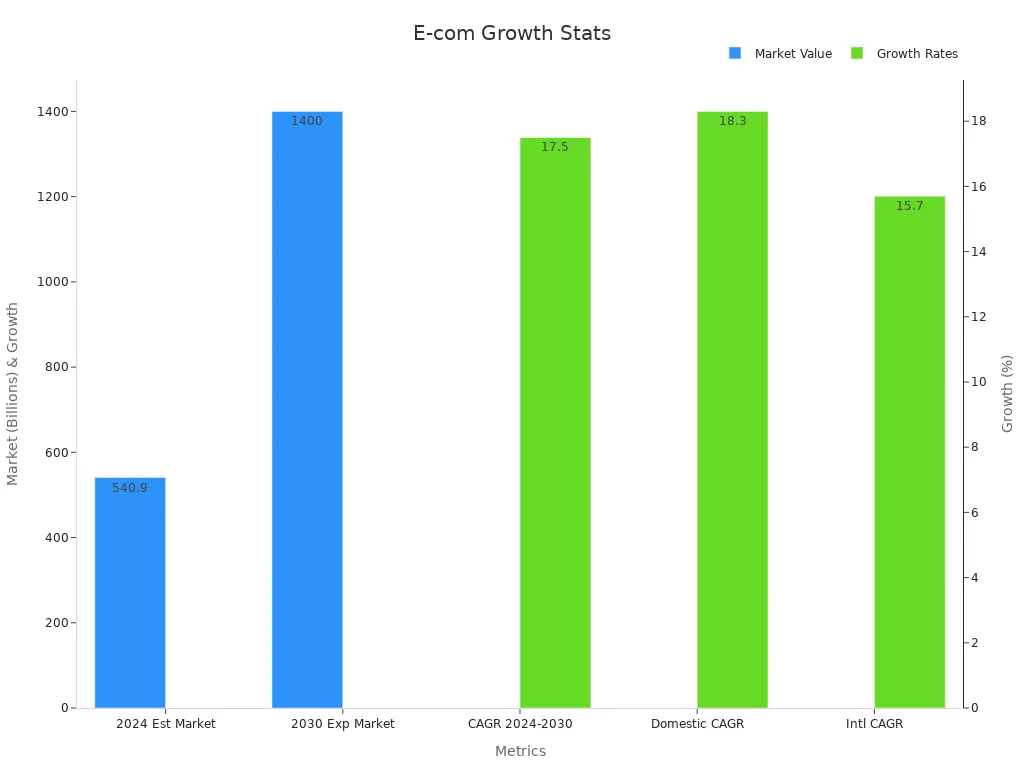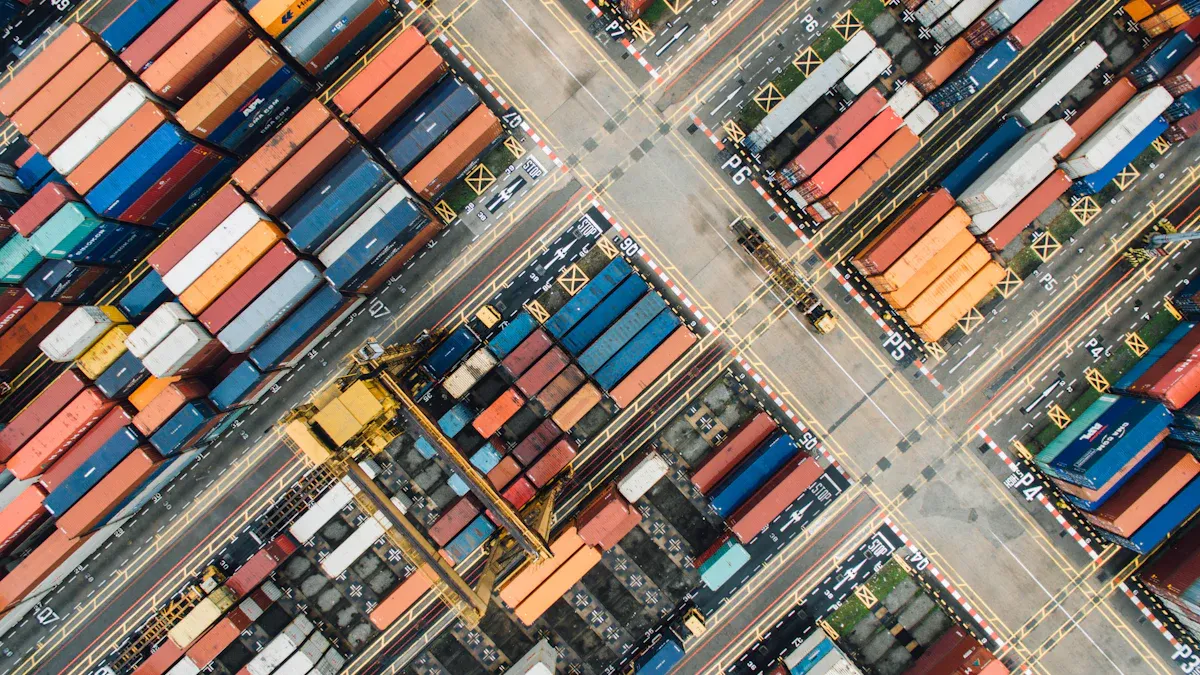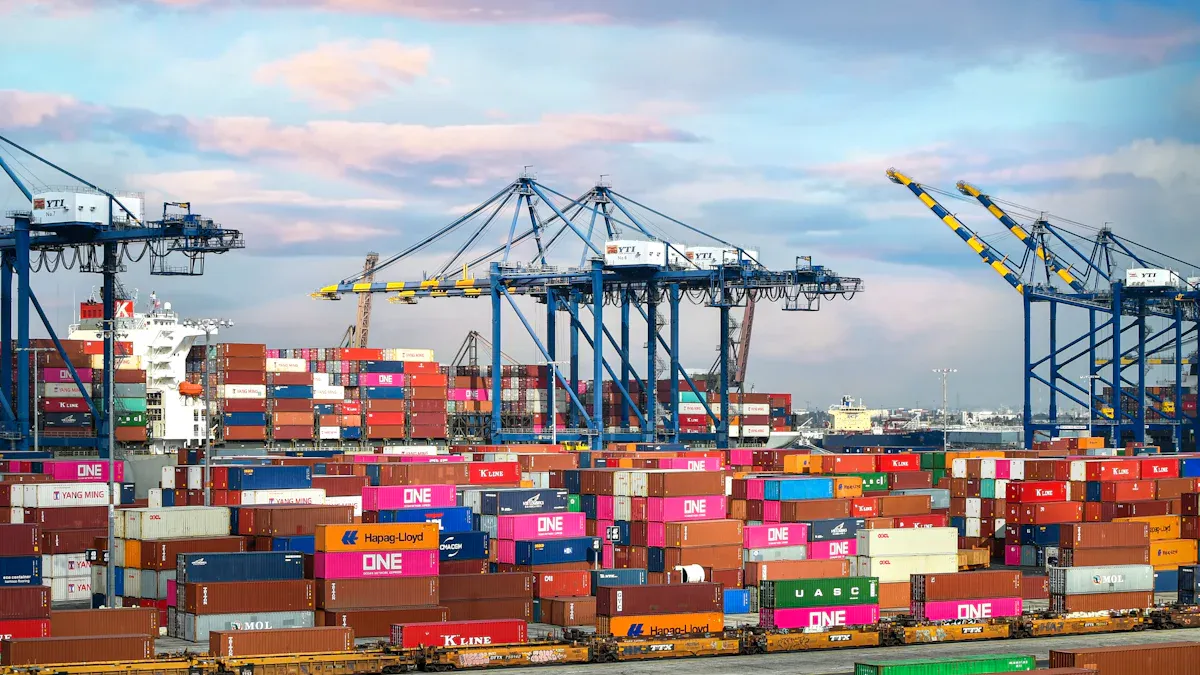Emerging Trends in E-Commerce Logistics and Fulfillment

E-commerce logistics has transformed into a driving force behind global trade. The market, valued at USD 457.5 billion in 2023, is expected to reach USD 1,023.8 billion by 2032, growing at a CAGR of 9.4%. Businesses must innovate and adapt swiftly to meet this explosive growth and sustain their competitive edge.
Key Takeaways
Online shopping delivery is growing fast, expected to hit $1,023.8 billion by 2032. Companies need to adjust quickly to compete.
Shoppers now want faster deliveries, with 68% choosing quicker options. Businesses should work on speeding up deliveries to satisfy them.
Using technology like AI and robots makes delivery better. Companies can save money and be more accurate with these tools.
Understanding the Current E-Commerce Logistics Landscape
The Impact of E-Commerce Growth on Logistics
The rapid expansion of e-commerce has revolutionized logistics operations worldwide. As online shopping becomes more prevalent, logistics providers face increasing pressure to handle higher delivery volumes efficiently. Over the past five years, daily delivery volumes surged from 20 million to 50 million packages, reflecting the growing demand for seamless order fulfillment. This growth has also driven operational costs up by 30% to 60%, challenging businesses to optimize their supply chain strategies.
The global e-commerce logistics market demonstrates this upward trajectory. In 2024, the market size is projected to reach USD 493.3 billion, with a forecast of USD 1,489.2 billion by 2033, growing at a compound annual growth rate (CAGR) of 12.91%. Retail e-commerce sales, estimated at $4.9 trillion in 2021, are expected to grow by 56% to $8.1 trillion by 2026.

Key Emerging Trends in E-Commerce Logistics

Technology Integration and Automation in Logistics
Technology is revolutionizing e-commerce logistics by streamlining operations and boosting efficiency. Automation reduces manual tasks, enabling faster order fulfillment and improved accuracy. A recent IBM survey revealed that 60% of businesses prioritize workforce productivity and agility when adopting automation solutions. Metrics like inventory turnover rates and order fulfillment times highlight the tangible benefits of technology integration.
Artificial intelligence (AI) and robotics play a pivotal role in optimizing logistics. Predictive analytics enhance demand forecasting, while automated systems accelerate warehouse operations. Companies leveraging these technologies report significant cost reductions and operational improvements.
Sustainability and Eco-Friendly Practices in E-Commerce
Sustainability has become a critical focus in e-commerce logistics. Consumers increasingly demand eco-friendly shipping options, with 73% willing to change their habits to reduce environmental impact. Over half of U.S. and U.K. shoppers prefer retailers to minimize packaging waste.
The logistics sector's carbon footprint rivals that of major nations, emphasizing the need for green practices. Smart package lockers, projected to grow by 40%, reduce emissions by consolidating deliveries. By adopting sustainable strategies, businesses can align with consumer values and enhance brand loyalty.
Innovations in Last-Mile Delivery Solutions
Last-mile delivery remains a costly and complex challenge, accounting for 53% of total shipping expenses. Innovations like drones and autonomous vehicles are transforming this segment. By 2025, 85% of packages could be delivered using these technologies, significantly reducing delivery times and costs.
Evidence Description | Impact |
|---|---|
Enhanced route planning efficiency | |
3x increase in daily deliveries | Improved delivery capacity |
Drones consume 94% less energy per package | Lower operational costs and emissions |
Smart package lockers also simplify returns and improve customer satisfaction, addressing the growing demand for seamless last-mile solutions.
Consumer-Centric Strategies for Personalized Fulfillment
Personalization has become a cornerstone of e-commerce logistics. Consumers expect tailored experiences, from marketing to delivery. Hyper-personalization fosters loyalty by creating unique shopping journeys.
Key Factors | Description |
|---|---|
Tailors efforts to enhance consumer satisfaction | |
Data-Driven Visibility | Improves efficiency and operational transparency |
Hyper-Personalization | Differentiates brands and builds long-term customer loyalty |
Retailers must adapt their strategies to balance consumer demands with operational efficiency, ensuring a seamless and satisfying experience.
The Rise of Omnichannel Fulfillment Models
Omnichannel fulfillment has redefined retail logistics. The growth of mobile technology and e-commerce has shifted consumer behaviors, requiring seamless integration across channels. Advanced technologies like AI and machine learning enhance efficiency and accuracy in omnichannel operations.
Retailers adopting these models can meet diverse consumer expectations while optimizing supply chains. As cross-border e-commerce grows to 25% of total sales by 2025, omnichannel strategies will become essential for global success.
Challenges in Adapting to Emerging Trends
Balancing Cost-Efficiency with Sustainability Goals
Businesses face the dual challenge of maintaining cost-efficiency while adopting sustainable practices. Many companies are transitioning to eco-friendly solutions, such as electric vehicles and energy-efficient equipment, to reduce their carbon footprint. Optimizing delivery routes has proven effective in cutting fuel consumption and operational costs. Collaborating with environmentally conscious suppliers and adopting minimal packaging strategies further align sustainability with budget constraints. Advanced software for route optimization also minimizes unnecessary mileage, enhancing both efficiency and environmental impact. These efforts demonstrate how businesses can balance profitability with sustainability in e-commerce logistics.
Managing Complexities in Last-Mile Delivery
Last-mile delivery remains one of the most intricate aspects of logistics. Fleet optimization becomes challenging when managing diverse package sizes and delivery priorities, often leading to inefficiencies. Machine learning algorithms now dynamically adjust routes based on real-time data, reducing delays and fuel costs. Predictive models also help forecast peak demand periods, ensuring resources are allocated effectively. Despite these advancements, last-mile delivery accounts for 53% of total shipping expenses, emphasizing the need for continuous innovation to streamline operations and meet consumer expectations.
Keeping Pace with Rapid Technological Advancements
The rapid evolution of technology demands swift adaptation. A McKinsey Global Survey revealed that the pandemic accelerated digital technology adoption by three to four years. Today, 96% of carriers and 86% of shippers rely on cloud-based systems, showcasing a significant shift toward modern logistics solutions. Digital freight specialists highlight the importance of technology in optimizing freight matching and addressing capacity gaps. Companies must remain agile to integrate these advancements and maintain a competitive edge in the fast-paced e-commerce logistics landscape.
Addressing Workforce Challenges in Logistics
The logistics sector faces significant workforce challenges, including high turnover rates and an aging workforce. Nearly 80% of loading dock employees have less than two years of tenure, with 40% having less than one year. This lack of experience contributes to inefficiencies and workplace injuries, which increased by nearly 20% in 2021. To address these issues, businesses must invest in training programs, improve workplace safety, and adopt automation to reduce dependency on manual labor. These measures can enhance productivity and create a more stable workforce.
Meeting Diverse Consumer Demands Across Regions
Consumer expectations vary widely across regions, complicating logistics operations. Shoppers increasingly demand free and fast shipping, real-time tracking, and hassle-free returns. Retail inventory distortion costs businesses approximately $1.1 trillion globally each year, highlighting the need for precise inventory management. Additionally, 56% of consumers report experiencing delivery delays during peak shopping periods. Companies must adopt region-specific strategies, such as localized warehouses and tailored delivery options, to meet these diverse demands effectively.
Practical Solutions for E-Commerce Logistics Adaptation
Leveraging JUSDA's Warehouse Solutions for Efficiency
Efficient warehousing is the backbone of successful e-commerce logistics. JUSDA's advanced warehouse solutions offer businesses a competitive edge by optimizing inventory management and streamlining operations. With over 2.5 million square meters of global warehouse space, JUSDA provides tailored solutions for industries ranging from electronics to automotive. Its facilities integrate cutting-edge technologies like eVMI and JusLink, enabling real-time inventory tracking and control. This transparency minimizes errors and ensures seamless order fulfillment.
Value-added services such as picking, packing, and labeling further enhance operational efficiency. For instance, JUSDA's cleanroom facilities meet stringent environmental standards, making them ideal for high-tech industries. By leveraging these solutions, businesses can reduce logistics costs and improve customer satisfaction.
Tip: Companies seeking to scale their operations should consider JUSDA's global warehousing network to ensure consistent service quality across regions.
Enhancing Supply Chain Visibility with JusLink Technology
Supply chain visibility is crucial for maintaining efficiency and meeting consumer expectations. JUSDA's JusLink platform integrates technologies like RFID and centralized visibility systems to provide real-time logistics synchronization. This innovation eliminates redundant inventory and enhances operational accuracy. Businesses using JusLink report significant improvements in supply chain transparency, enabling them to respond swiftly to market demands.
Real-time tracking also reduces uncertainties, ensuring timely deliveries. By adopting JusLink, companies can achieve zero-redundancy inventory, a critical factor in optimizing e-commerce logistics. This level of visibility not only boosts efficiency but also builds consumer trust through reliable service.
Partnering with Third-Party Logistics (3PL) Providers
Collaborating with third-party logistics providers offers businesses the flexibility to adapt to market changes. In the 2020 Third Party Logistics Study, 79% of 3PLs reported improved profitability, with 33% experiencing growth exceeding 25%. These partnerships allow companies to scale operations without significant infrastructure investments.
The 3PL industry has grown at a CAGR of 4.8% over the past five years.
Revenue is projected to reach $101.6 billion by 2024.
By outsourcing logistics, businesses can focus on core competencies while leveraging the expertise of 3PL providers. This approach ensures efficient order fulfillment and enhances customer satisfaction.
Investing in Sustainable Packaging and Transportation
Sustainability is no longer optional in e-commerce logistics. Companies are increasingly adopting eco-friendly practices to align with consumer values and reduce environmental impact.
Evidence Description | Figure |
|---|---|
Percentage of leaders increasing investments | |
Companies incorporating eco-friendly materials | 59% |
CAGR of green logistics market | 6.1% through 2028 |
Sustainable packaging market growth | From USD 313.73 billion in 2025 to USD 557.65 billion by 2034, CAGR of 6.6% |
Investing in sustainable packaging and transportation methods not only reduces carbon footprints but also enhances brand loyalty. Businesses adopting these practices can differentiate themselves in a competitive market.
Building Flexible and Scalable Fulfillment Networks
A flexible and scalable fulfillment network is essential for adapting to market fluctuations. Fulfillment centers enable businesses to adjust staffing and capacity based on order volumes, avoiding long-term infrastructure investments.
Metric | Benefit |
|---|---|
Competitive Advantage | Companies can adapt to market changes without sacrificing service quality. |
Operational Efficiency | Logistics networks evolve to support growth and maintain cost control. |
3PLs assess and mitigate fulfillment risks effectively.
They implement contingency plans to ensure uninterrupted operations.
Insurance policies protect against inventory loss or damages.
By building scalable networks, businesses can maintain operational efficiency while meeting diverse consumer demands.
JUSDA's Role in Shaping the Future of E-Commerce Logistics

How JUSDA's Global Warehousing Network Supports E-Commerce
JUSDA's extensive global warehousing network plays a pivotal role in supporting e-commerce operations. By strategically positioning warehouses across key regions, JUSDA ensures faster delivery times and optimized inventory management. Its facilities integrate advanced technologies like real-time tracking and dynamic inventory systems, enabling businesses to meet the growing demands of e-commerce logistics.
Region | Key Operations | Strategic Focus |
|---|---|---|
North America | Operations in the US and Mexico focusing on cross-border VMI services | Enhancing response times and competitiveness in high-value markets like electronics and automotive. |
Vietnam | Establishing VMI + CMI collaborative warehouses | Managing over 20,000 SKUs and facilitating logistics in Southeast Asia. |
India | Integrating with local supply chains for electronic components | Supporting domestic industry competitiveness through efficient warehousing and distribution systems. |
Global | Advanced digital solutions for supply chain management | Real-time tracking, dynamic inventory management, and automation to enhance operational efficiency. |
Sustainability | Initiatives to reduce carbon footprint and align with global environmental standards | Meeting demand for green logistics while improving overall efficiency and cost-effectiveness. |
This robust network empowers businesses to scale operations globally while maintaining efficiency and sustainability.

After the update
Supply Chain Management Solution
Industry-Specific Solutions for E-Commerce Logistics Challenges
JUSDA addresses industry-specific challenges with tailored logistics solutions. The ongoing e-commerce boom has heightened consumer expectations for faster deliveries and sustainable practices. JUSDA leverages cutting-edge technologies to meet these demands.
Last-mile delivery: Crowd-sourced delivery networks and local hubs streamline operations.
Speed of delivery: Automation and AI enhance efficiency.
Demand forecasting: Big data analytics improve accuracy.
Customer satisfaction: Real-time tracking and improved communication build trust.
Sustainability: Eco-friendly practices and electric vehicles reduce environmental impact.
A fintech company, for instance, utilized big data to optimize its supply chain, achieving a 20% reduction in inventory costs. These innovations demonstrate JUSDA's commitment to solving complex logistics challenges and driving success for its clients.
E-commerce logistics continues to evolve, driven by innovation and the need for sustainability. Businesses adopting advanced strategies, such as third-party logistics and forward logistics, gain a competitive edge. For example, forward logistics dominates 69% of the market, while 76% of companies prefer third-party models for scalability.
JUSDA's expertise in global warehousing and real-time supply chain solutions positions it as a trusted partner for navigating this dynamic landscape. Businesses leveraging JUSDA's innovative services can thrive in the competitive e-commerce environment.
See Also
Navigating Tomorrow's Logistics Through Digital Innovations
Understanding Emerging Trends in Logistics Risk Management
Boosting Warehouse Efficiency With Advanced Robotics Solutions
Five Key Trends Shaping Future Supply Chain Efficiency
Transforming Logistics Through Innovative Supply Chain Strategies
